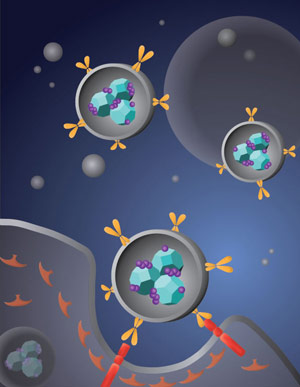
Using nanoscale diamond-like particles called nanodiamonds, researchers have developed a potentially more effective treatment for “triple-negative” breast cancer, notably decreasing tumor growth and eliminating the devastating side effects of cancer treatment during testing with mice.
Recently, doctors have begun to categorize breast cancers into four main groups according to the genetic makeup of the cancer cells. Which category a cancer falls into generally determines the best method of treatment.
But cancers in one of the four groups — called “basal-like” or “triple-negative” breast cancer (TNBC) — have been particularly tricky to treat because they usually don’t respond to the “receptor-targeted” treatments that are often effective in treating other types of breast cancer. TNBC tends to be more aggressive than the other types and more likely to recur, and can also have a higher mortality rate.
Fortunately, better drug therapies may be on the horizon. UCLA researchers and collaborators led by Dean Ho, a professor at the UCLA School of Dentistry and co-director of the school’s Jane and Jerry Weintraub Center for Reconstructive Biotechnology, have developed a potentially more effective treatment for TNBC that uses nanoscale, diamond-like particles called nanodiamonds.
Nanodiamonds are between 4 and 6 nanometers in diameter and are shaped like tiny soccer balls. Byproducts of conventional mining and refining operations, the particles can form clusters following drug binding and have the ability to precisely deliver cancer drugs to tumors, significantly improving the drugs’ desired effect. In the UCLA study, the nanodiamond delivery system has been able to home in on tumor masses in mice with triple negative breast cancer.
Findings from the study are published online on April 15 in the peer-reviewed journal Advanced Materials.
“This study demonstrates the versatility of the nanodiamond as a targeted drug-delivery agent to a tumor site,” said Ho, who is also a member of the California NanoSystems Institute at UCLA, UCLA’s Jonsson Comprehensive Cancer Center and the UCLA Department of Bioengineering. “The agent we’ve developed reduces the toxic side effects that are associated with treatment and mediates significant reductions in tumor size.”
The team combined several important cancer-fighting components on the nanodiamond surface, including Epirubicin, a highly toxic but widely used chemotherapy drug that is often administered in combination with other cancer drugs. The new compound was then bound to a cell-membrane material coated with antibodies that were targeted toward the epidermal growth factor receptor, which is highly concentrated on the surfaces of TNBC cells. The resulting agent is a drug-delivery system called a nanodiamond-lipid hybrid compound, or NDLP.
When tested on mice, the agent was shown to notably decrease tumor growth and eliminate the devastating side effects of cancer treatment.
Because of its toxicity, Epirubicin, when administered alone can cause serious side effects, such as heart failure and reduced white blood cell count, and it has been linked to an increased risk for leukemia. In the study, all of the mice that were given Epirubicin alone died well before the completion of the study. But all the mice given Epirubicin through the targeted NDLPs survived the treatment, and some of the tumors even regressed until they were no longer visible.
“Triple-negative breast cancer is often very aggressive and hard to treat, making aggressive chemotherapy a requirement,” said Dr. Edward K. Chow, co-first author of the study and an assistant professor at the Cancer Science Institute of Singapore. “The targeting and therapeutic efficiency of the nanodiamond-lipid agents were quite remarkable. The simultaneous tumor regression and improved drug tolerance are promising indicators for the continued development of the nanodiamonds toward clinical translation.”
The research team is now studying the efficacy and safety of the NDLPs in larger animals. Additional research objectives include determining whether nanodiamonds can enhance the tolerance of a wide spectrum of highly toxic drug compounds, which may improve current treatment options and outcomes. These discoveries will serve as precursors for human trials, the researchers said.
“The nanodiamond-lipid hybrid developed in this study is a modular platform,” said Laura Moore, a graduate student in Ho’s laboratory and a co-first author of the study. “Therefore, we can easily bind a wide spectrum of targeting antibodies and drug compounds to address several diseases.”
Dr. No-Hee Park, dean of the UCLA School of Dentistry, noted that the research will provide a foundation for future clinical applications.
“This pioneering study conducted by Dean Ho and his team provides a better understanding of the capabilities of the nanodiamond material to address several diseases,” Park said. “Their work is of paramount importance.”
Reference: “Diamond-Lipid Hybrids Enhance Chemotherapeutic Tolerance and Mediate Tumor Regression” by Laura Moore, Edward Kai-Hua Chow, Eiji Osawa, J. Michael Bishop and Dean Ho, 15 April 2013, Advanced Materials.
DOI: 10.1002/adma.201300343
Other authors of the study were Professor Eiji Osawa of the NanoCarbon Research Institute in Nagano, Japan, and Professor J. Michael Bishop of UC San Francisco. Laura Moore is currently at Northwestern University.
The study was supported by the National Cancer Institute, the National Science Foundation, the Wallace H. Coulter Foundation, the V Foundation for Cancer Research, the Society for Laboratory Automation and Screening, the George Williams Hooper Foundation, the American Cancer Society, Beckman Coulter, the European Commission, the Cancer Science Institute of Singapore, and the Singapore Ministry of Education Academic Research Fund.
1 Comment
Diamonds are a girl’s breast friend?
You’re welcome. Someone had to do it. Shut up.